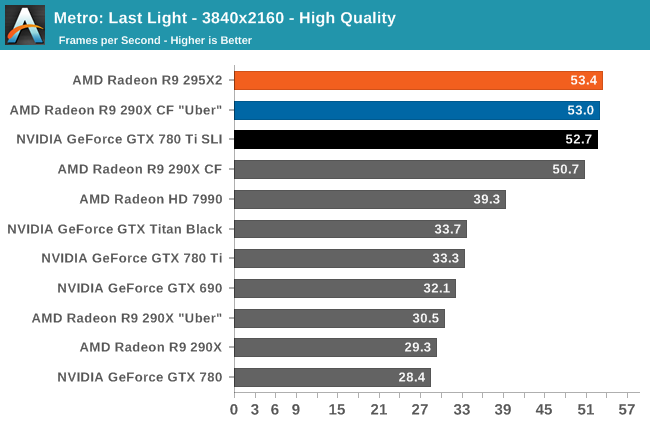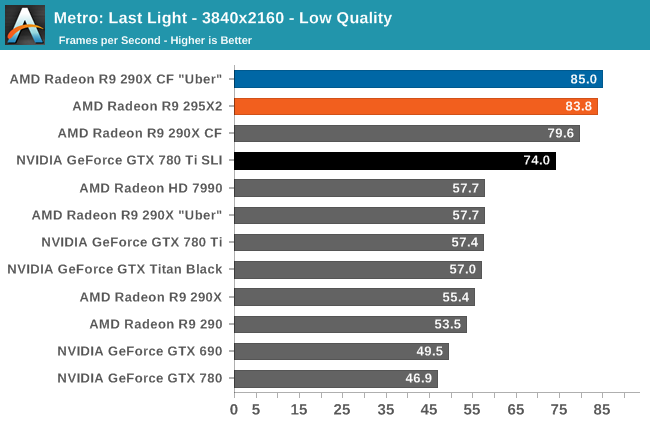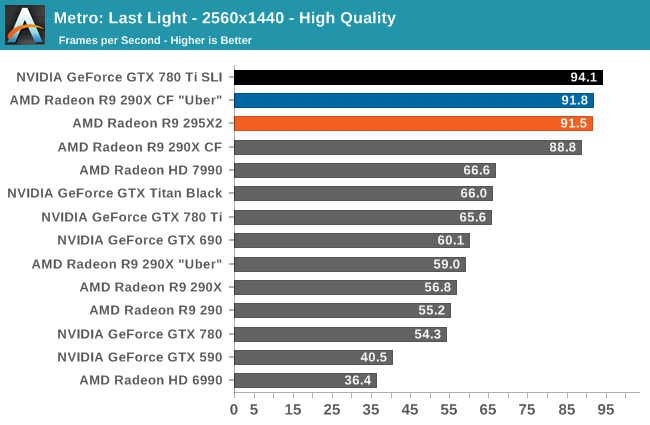The AMD Radeon R9 295X2 Review
by Ryan Smith on April 8, 2014 8:00 AM EST- Posted in
- GPUs
- AMD
- Radeon
- Radeon 200
Metro: Last Light
As always, kicking off our look at performance is 4A Games’ latest entry in their Metro series of subterranean shooters, Metro: Last Light. The original Metro: 2033 was a graphically punishing game for its time and Metro: Last Light is in its own right too. On the other hand it scales well with resolution and quality settings, so it’s still playable on lower end hardware.



Our first gaming benchmark pretty much sets the tone for what we’ll be seeing in this review. In building the 295X2 AMD set out to build a single card that could match the performance of the 290X “Uber” In Crossfire, and that is exactly what we see happening here. The 295X2 and 290XU CF swap places due to run-to-run variation, but ultimately both tie together, whether it’s above the GTX 780 Ti SLI or below it.
As we’ve already seen with the 290X, thanks in part to AMD’s ROP advantage, AMD’s strong suit is in very high resolutions. This leads to the 295X2 edging out the competition at 2160p, while being edged out itself at 1440p. None the less between AMD and NVIDIA setups this is a very close fight thus far, and will be throughout. As for Metro, even at the punishing resolution of 2160, the 295X2 is fast enough to keep this game going at above 50fps.










131 Comments
View All Comments
Smartgent - Tuesday, April 8, 2014 - link
The card is watercooled!! not aircooled like Nividia chose to do with their 500W TitanZ. Ishould run very quiet, and should not affect your internal temps much, as long as you mount the radiator externally to your case.Ian Cutress - Tuesday, April 8, 2014 - link
It's a shame they're not making a version with a larger liquid cooler. Would like to see it with a 2x120 CLC and an overclock.jtd871 - Tuesday, April 8, 2014 - link
This card should have just been released with a full-cover block and let the enthusiasts/3rd-parties use whatever custom cooling they like.Rambon3 - Tuesday, April 8, 2014 - link
Great article. I wish I had a spare grand and a half to replace my 7970 CF set up. BTW It looks like you have an extra GPU Load temp chart on Page 17 where the Load noise chart should be positioned.randomhkkid - Tuesday, April 8, 2014 - link
I may have missed it in the article but I don't think you mentioned whether or not it would be possible to add an additional fan on that asutek cooler? This would surely bring down stock temperatures (albeit increase the noise) if one was thinking about overclocking further.Ryan Smith - Tuesday, April 8, 2014 - link
Yes, it's possible. You would need to come up with a matching fan and the screws to mount it, but there's nothing from a hardware perspective keeping you from mounting a second fan for push-pull. I don't know if it's easily visible in our pictures, but the fan power connector is exposed mid-way along the cable run, so you can split it there to get a second fan power header.mpdugas - Tuesday, April 8, 2014 - link
push-pull, perhaps?Gunbuster - Tuesday, April 8, 2014 - link
The perfect card for high resolution multi monitor rigs, oh wait frame pacing is still broken. Don't worry, just send in your $1500 and they'll fix it sometime in 2015 (maybe)JDG1980 - Tuesday, April 8, 2014 - link
Pay closer attention to the article. Frame pacing is still imperfect *on the old 7990*, not on the R9 295X2. It works fine on GCN 1.1 cards (290/290X/295X2) due to the new XDMA engine.Admittedly, it was odd for them to throw in some 7990 bashing in the review of a new card, so I can understand the confusion.
Mondozai - Tuesday, April 8, 2014 - link
Why are you asking people to pay attention to articles they are commenting on?This is the internet.